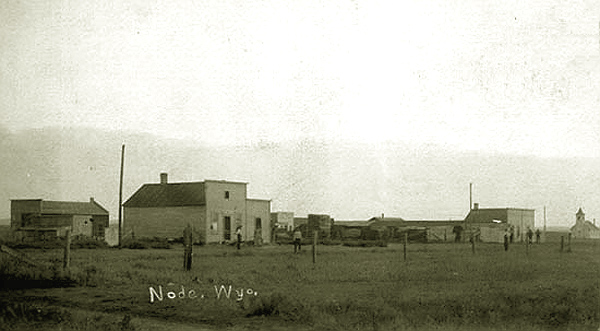
Node, Wyoming, approx. 1914.
About twelve miles west of Van Tassell and eight miles east of Lusk is Node. The false-fronted building to the left of center with the barn behind it is the DeHoff & Son store owned by Clarence C. DeHoff. The store sold
dry goods, groceries, dry-goods and farming implements. The store also housed the post office of which
DeHoff was the postmaster. In the distance is the Lutheran Church.
Node derived its name from the
Node Ranch founded prior to 1880. "Node" refered
to a brand held by the ranch in the shape of a knot or node. The ranch was at one time owned by the Western Live
Stock Company in which Frank Lusk held an
interest. The ranch was sometimes referred to as the "Flying E."
In 1894, the Node Ranch was sold to Thomas Bell who operated as the Tom Bell Cattle Co. Tom Bell was originally from Portneuf, Quebec. His
family moved to Richland, Nebraska in 1867 when Tom was four years of age. His father died in 1877 and his mother remarried.
Bell came to Wyoming on his own at 15 and was employed by Swan and later by Charles F. Hecht as a range rider. For Hecht, he rode line along
Young Woman and Lightening Creeks. On occasion he shared a dugout line cabin with a cowboy working for the
OW, John Kendrick. Kendrick later became governor and a United States Senator. Bell would also share the
dugout with the horses, the horses being separated by a canvas wall.
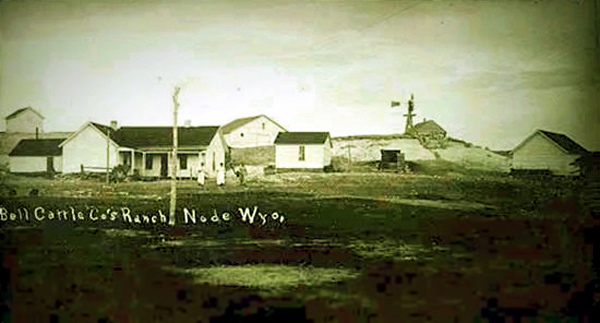
Tom Bell Cattle Co., undated.
After he purchased the ranch, Bell discontinued
use of the Node brand. Instead Bell used a "carlink" brand. Bell ran principally a hereford-short horn mix. Bell served as the first chairman of the
Board of County Commissioners upon the formation of Niobrara County. The town, however, retained the Node name. Bell ultimately retired to
Florida.
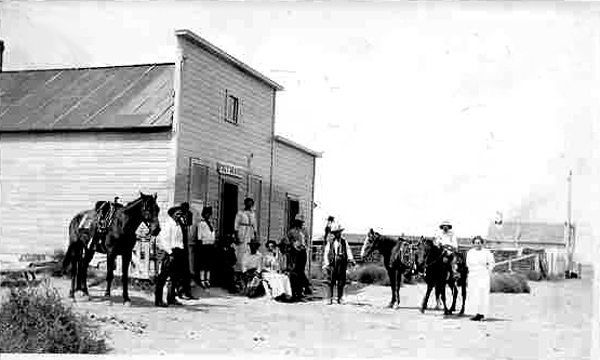
DeHoff & Son Store, Node, Wyo., 1914
The post office was not established until 1910 when Peter Hansen was designated as
postmaster. He maintained the
office at his homestead.The post office was later moved to the DeHoff Store.
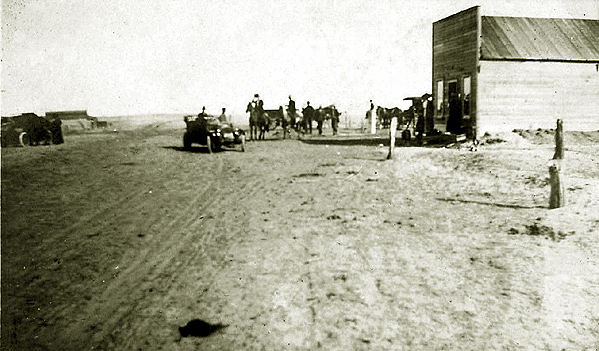
Node, approx. 1910
with an influx of homesteaders attracted by the promise of dryfarming, in January 1914 a second
store was esablished by Peter Hansen and John Ohlsen. The DeHoff Store was previously adverstised as the
"The Node Store." From January to the end of May, 1914 Hansen and Ohlsen advertised on lower right page 4 of the Van Tassell Pioneer and the
Lusk Herald as "Node's New Store." for the five months each of the Hansen and Ohlsen ads were matched center bottom page
4 with a corresponding ad for DeHuff's Node Store. In August Burnaugh's Cash Store appeared and then
disappeared from the advertising columns. DeHuff then reverted to his two line mentions under Node news.
But Node was already beginning to fade. In 1915, a tornado blew the railroad section house off its
foundations, flooded stores in the business section, and scattered Ohlsen's house across the prairie. Ub 1916, the DeHuff store was sold and subsequently sold to I. M. Jones who had a
store in Van Tassell.
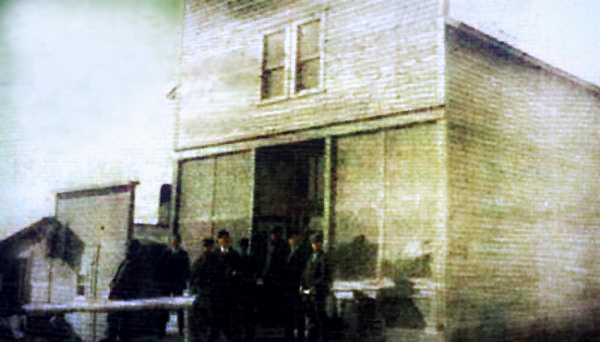
unidentiied building, Node, Wyo., approx. 1916.
In 1914, the Reverend Annette B. Gray, Assistant Superintendent for the Congretational Churches in
Wyoming and a correspondent for the American Missionary Magazine wrote:
TRAVELING west from the Nebraska border on the Northwestern railway in
Wyoming, one comes first to the little new village of Van Tassell with i
ts pretty church. The train pushes on over the great undulating plains,
where great ranches are being cut up into smaller holdings for dry-farming.
New families are coming in to occupy the scattered homes of which you get
a glimpse on the horizon. They are from Iowa, Wisconsin, Illinois and other
states farther east.
Presently the whistle blows for Node. There is only a nucleus of a
few houses as yet. The place claims only a hundred and forty people
within three miles. But they are mostly Americans, engaged in farming
and stock raising. The bounds of the parish are much wider than this,
and some of the members of our little church organized a year ago live
five or ten miles away.
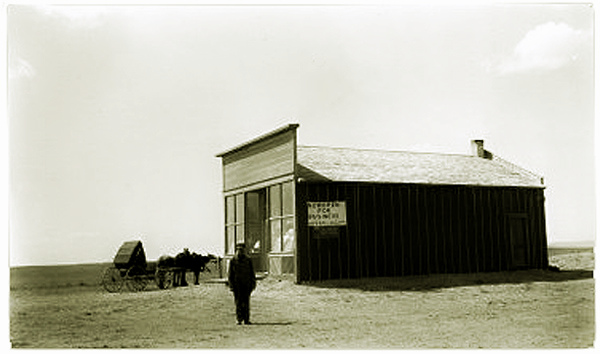
Unidentified building, Node, Approx. 1910.
The Reverend Gray continued:
Had you been in Node a year ago, you would have seen no church there.
But the people felt that they must have a place of worship, and a generous
man gave a lot near the station on which to build. The people took hold
of the task with great enthusiasm and self-sacrifice, and pushed the work
through the winter so that on April 5th, 1914, they had the feast of
dedication, with Superintendent and Mrs. Gray to share in the services
with the pastor, Rev. George Dalzell. The picture shows what a fine lot
of people our frontier churches can gather. This is the only
English-speaking church in the community, one other church being a
German Lutheran. American Missionary, "What They Did in Node, Wyoming", vol. 68, p. 484 (1914)
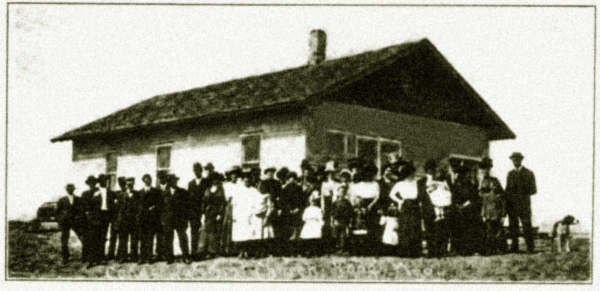
Node Congregational Church, approx. 1914.
The comment by the Reverend Mrs. Gray about the train whisle for Node was appropriate, it probably never amounted
to much more than a whistle stop as indicated by the size of the railroad station.
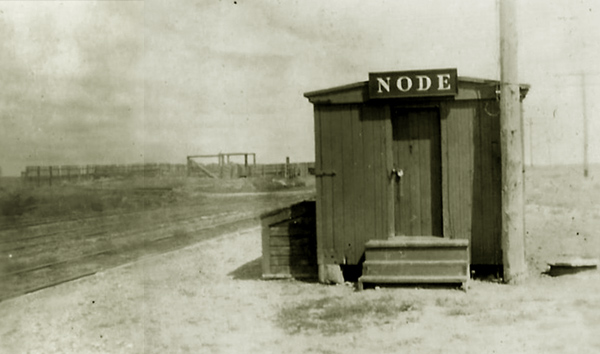
Node Depot, undated.
With the decline of Dry Farming, Node had declined to a population of 25 by the late 1930's.
By the late 1980's the town had declined to a population of three. The Post office offically closed at the end of
business, October 8, 1991.
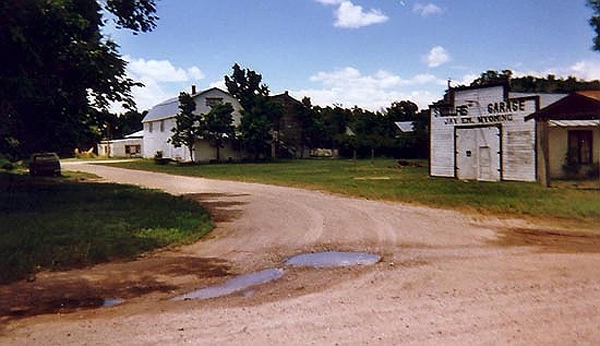
Jay Em, Wyoming, 2005. Photo by Geoff Dobson.
Jay Em south of Lusk, traces its beginnings to about 1869, when James Moore started
the J M along Rawhide Creek about two miles north of the
present town of Jay Em. Moore in conjunction with Charles
Moore owned ranches on the North Platte at Cedar Creek, Nebraska, and on the
South Platte near present day Stirling, Colorado. During the short life of the
Pony Express, Jim Moore was a rider between Midway and Julesburg. The division from Mud Springs to Julesburg was sometimes referred
to as the "Jules Stretch" after the line's superintendent Jules Beni. Beni, as discussed with regard to
the Overland Stage, died at the hands of Jack Slade. On June 8, 1860, Moore made his epic
280-mile round trip from Midway to Julesburg and back in 14 hours and 46 minutes, changing mounts at Julesbvrg,
Thirty-Mile Ridge, Mud Springs and ending at Midway. Moore averaged over 18 miles per hour.
The ride was described by Col. Henry Inman and
Col. Cody in their 1898 The Great Sale Lake Trail:
James Moore, the first post-trader at Sidney, Nebraska, made a ride
which may well lay claim to be one of the most remarkable on record.
He was at Midway Station, in Western Nebraska, on June 8, 1860, when
a very important government despatch [sic] for the Pacific coast arrived.
Mounting his pony, he sped on to Julesburg, one hundred and forty
miles away, and he got every inch of speed out of his mounts.
At Julesburg he met another important government despatch for
Washington. The rider who should have carried the despatch east had
been killed the day before. After a rest of only seven minutes and
without eating a meal, Moore started for Midway, and he made the round
trip, two hundred and eighty miles, in fourteen hours and forty-six
minutes. The west-bound despatch reached Sacramento from St. Joseph
in eight days, nine hours, and forty minutes.
Moore sold the ranch to Van Tassell. Later, after Moore's death, Van Tassell married Moore's widow.
The Town of Jay Em, twenty-three miles south of Lusk in Goshen County, was founded by Lake C. Harris (1889-1983) about 1905.
The town was named after Jim Moore's J M Ranch.
Harris claimed a homestead in 1912. At one time, the little town
had a post office, grocery store, hardware, garage, and the Farmer's State Bank of Jay Em which opened in
1920 and sold out in 1945. The bank was one of the few that did not close during President
Franklin Roosevelt's bank moratorium. (The bank did not get the word.) Shoults Garage in the photo
was operated by James Alan Shoults (1891-1973) between 1928 and 1945. A blacksmith shop was behind
the garage. Shoults sold out to Wolfe's Repair. The barns in the distance housed the
hardware and grocery.
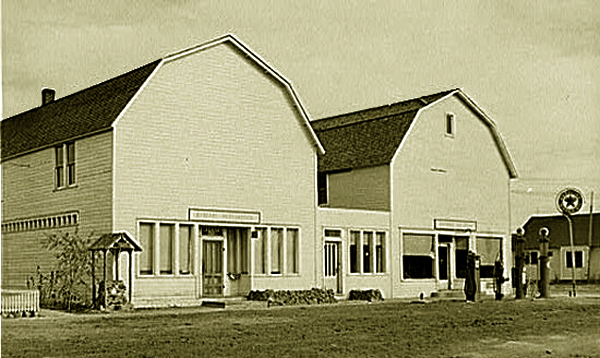
Jay Em, Wyoming, 1940. Photo by John Vachon, courtesy of
Library of Congress.
Upstairs on one side was a hall for dances and other community functions. John Vachon (1914-1975) was a photographer for the Farm Security Administration from 1936 to 1943. Following
World War II, he was a photographer for Look Magazine.
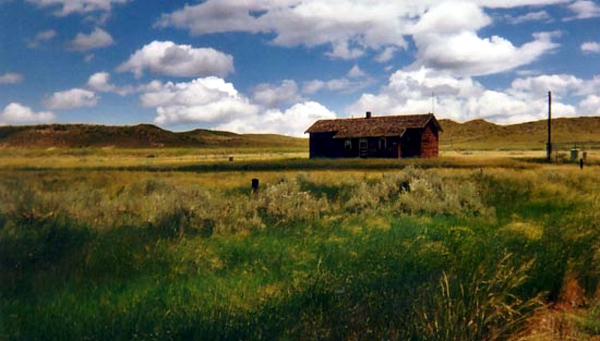
Schoolhouse, Jay Em, Wyoming, 2005. Photo by Geoff Dobson.
Next Page: Manville and Keeline.
|